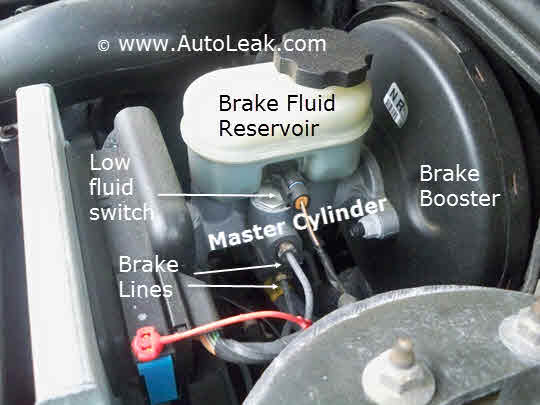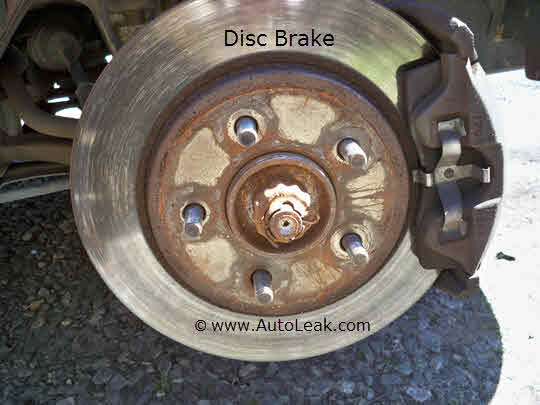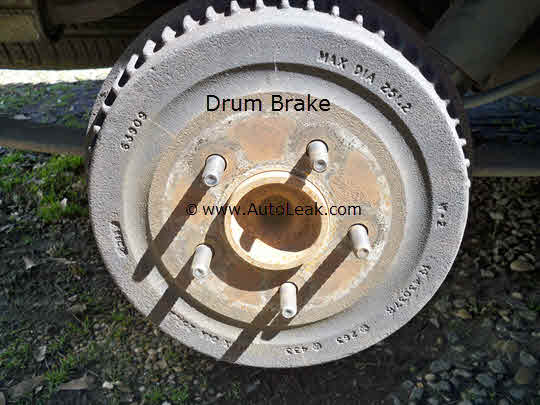Brakes *** Caution ***
Do not work on Brakes without understanding that people can get hurt and or die if a mistake is made. You may not realize a mistake has been made until the brakes are really needed.
If you do not feel comfortable working on brakes, hire a professional to do it for you!
Antilock Brake Systems (ABS) add complexity to brake systems. Brakes systems with ABS not properly worked on, can cause death and or injury. Special caution must be used with ABS.
Any information provided on this web site about repairs is followed at your own risk.
Brakes
There is two basic components of a braking system:
1 - Method for application of the brakes.
2 - Braking device that slows down the motion.
Vehicle braking can be applied in several different ways.
- Hydraulic Fluid Brakes
Hydraulic Fluid Brakes use hydraulic fluid to work and is the most common in cars and small trucks. A piston inside a master cylinder is pushed by the driver which pushes hydraulic fluid to other pistons at the brakes. To assist the driver with applying the brakes, a brake booster is normally used which applies additional pressure to the piston being pushed on by the driver.

- Air Brakes
Air Brakes use air to work and these brakes tend to be used on heavy vehicles such as buses, trucks, trains etc. They allow easy connection of trailers and since the air is generated via the vehicle they have a constant source even if there are leaks present in the braking system. Driver when applying the brakes, releases pressurized air into the breaking system which is then applied to pistons at the brakes.
- Wire
When brakes are applied, an electric signal is sent along a wire triggering an electric braking device. Used on electric trailer brakes and in modern cars that use computer controlled brakes.
- Downshift of transmission
Transmission of the car is put into a gear ratio (down shifted) that makes the wheels turn the vehicle engine at a rate of turn which causes the engine turning to slow down the car when the accelerator is not being used. Commonly used with manual transmissions.
- Mechanical Brakes
All vehicles started out with Mechanical Brakes and you can still see this technology on motorbikes and bicycles today as well as in the parking/emergency brakes of most cars. It involves mechanical linkages such as cables or levers that apply physical force to the brakes.
- ABS
Anti-lock Braking System detects when the wheels that are being slowed down have stopped rotating and momentarily releases the brakes to allow the wheel to rotate again even if the driver is still applying the brakes.
Braking Devices.
- Disc Brakes

A rotor spins between brake pads. This rotor could be on the wheel or axle that drives the wheel. When the brakes are applied, the brake pads squeeze the rotor and use friction to slow down the rotor.
- Drum Brakes

A drum rotates around the outside of brake pads. The drum is usually part of the wheel. When the brakes are applied, the brake pads are pushed against the inside of the drum generating friction which slows the drum down. It is the opposite of the old wagon wheel brakes which applied a brake pad to the outside of the wagon wheel.
- Electric Brakes
Electric Brakes can be found on some trailers and electricity is used to activate them. Electric braking is different to Electric Regenerative Braking. Electric brakes will usually either be drum or disc. An electromagnetic component moves the brake pads into position rather than a hydraulic piston or air piston.
- Electric Regenerative Brakes
Hybrid electric cars and all electric cars have this. It is where the motion of the car is converted back into charging of the car batteries when the brake is applied. On board computer switches the electric drive motors into battery charge mode and the battery charging action slows downs the wheels / axles the electric motors are attached to.
- Hydraulic Regenerative Brakes
Some vehicles convert the motion of the vehicle into compression of gas when the brakes are applied. When brakes are applied, a pump is activated which pumps hydraulic fluid into a container that contains nitrogen gas. Nitrogen is separated from the hydraulic fluid by a diaphragm that compresses the Nitrogen as the pump is running. Energy required to pump the hydraulic fluid into the container comes from the motion of the vehicle which slows the vehicle down.
- Engine
This is where the engine of the vehicle is turned by the motion of the wheels (rather than combustion) and the effort required to turn the engine slows the vehicle down. Activated via downshifting the transmission.
Question or Solution not mentioned?
Use
Auto Repair Forum to ask or answer questions about car and auto repair.
Advertise your Auto/Car/Truck Repair Parts or Auto/Car/Truck Repair Business on this site.
Contact us at Advertising@AutoLeak.com
We have affordable advert solutions!
Act now to potentially reach thousands of unique people a month who are trying to repair/maintain their vehicles.